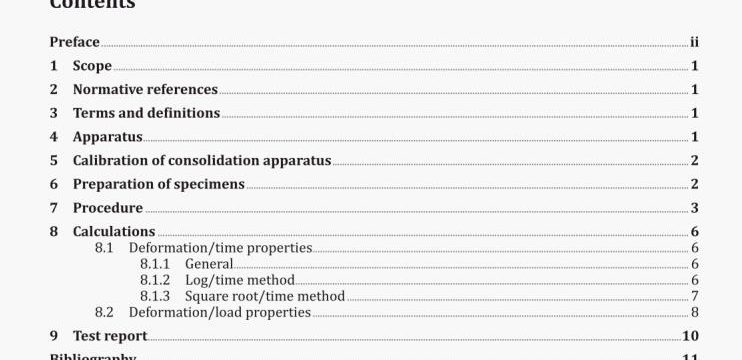Soil strength and consolidation tests — Determination of the one-dimensional consolidation properties of a soil
AS 1289.6.6.1-2020 pdf download.Methods of testing soils for engineering purposes
Method 6.6.1: Soil strength and consolidation tests — Determination of the one-dimensional consolidation properties of a soil — Standard method.
(I) Plates shall be a minimum of 0.3 mm and no more than 0.5 mm smaller in diameter than the ring to minimize extrusion of soil between the inner face of the ring and the plate.
(ii) Top plate shall be loaded through a corrosion-resistant loading cap of sufficient rigidity to prevent breakage of the plate.
(d) Dial gauge or transducer (LVDT) with a travel of at least 5 mm and readable to at least 0.002 mm.
(e) Trimming knife or wire saw.
(f) Filter paper.
(g) Oven — designed for soil engineering purposes and capable of drying a sample of soil to a constant mass.
5 Calibration of consolidation apparatus
The calibration shall be as follows:
(a) Moisten the porous plates. Assemble the consolidation cell with a metal disc of about the same thickness as the specimen and approximately 1 mm smaller in diameter than the ring in place of the specimen. Place filter paper layers in position as if they are to be used in the test.
(b) Load and unload the consolidation cell as in the test and measure the deformation for each load applied for a set period of 30 mm per load or unload.
(c) Table corrections to be applied to the deformation at the end of each cycle.
6 Preparation of specimens
Preparation of specimens shall be carried out in the following manner:
(a) Prepare a specimen, using one of the following methods:
NOTE 1 Care of the specimen: Precautions should be taken to minimize disturbance of the soil during preparation. Vibration, distortion, and compression should be particularly avoided.
(I) From a thin-walled sample tube, extrude a length of soil fortrlmmlng to the required test specimen dimensions using a trimming knife or wire saw.
(ii) From a block sample, trim a soil cylinder larger than the required test specimen dimensions using a trimming knife or wire saw.
(c) Using the lightly greased cell ring, gradually trim the specimen obtained in Step (a) into the ring using light force, while trimming the soil to fit the size of the ring with a trimming knife or wire saw.
(d) Trim the ends of the specimen flush with the ends of the cell ring, wiping all residue soil from the outside of the ring, and determine the mass of the ring plus specimen (m1). Subtract the mass of the ring to determine the initial wet mass of the specimen (m1 = m1 — m0).
(e) Using the trimmings of the specimen, measure the moisture content In accordance with
AS 1289 2.1.1 and record as the initial moisture content.
(f) Determine the apparent density of the soil particles (,s) as described in AS 1289.3.5.1 (line fraction only). For batches of tests on the same project and of the same geological origin, a reduced number of tests may be completed, and the value assumed to be the same.
7 Procedure
The procedure shall be conducted as follows:
(a) Dampen the porous plates as necessary to minimize any tendency to absorb water from the specimen. Assemble the consolidation cell with ring, specimen, filter paper on either side of the specimen and porous plates. Position the loading plate on top of the specimen.
(b) Place the consolidation cell in the loading device, set the dial gauge, record the reading, and then apply a small seating pressure.
NOTE 1 A seating pressure of 6.25 kPa ± 1 kPa is recommended for typical apparatus and soil. For very soft soils a seating pressure of 3 kPa or less may be used.
(c) Inundate the specimen with water.
NOTE 2 Inundation procedures vary depending on the soil consistency and moisture content. Inundate the specimen at the start of the test unless otherwise specified by the client. Specimens may be inundated at times or loads other than at the beginning of the test. Any resulting effects, such as expansion or Increased settlement, should be noted in the test report.
In the case of unsaturated soils, inundation may not he necessary, and the test would be carried out under conditions that minimize the loss of moisture by evaporation from within and around the specimen.
(d) Apply the first loading pressure and record the change in thickness of the specimen at the following time intervals: 7.5, 15, and 30 s; 1, 2, 4, 8, 16 and 32 mm; i, 2, 4, 8, and 24 h. The following loading pressure increments shall be used as the normal test range unless otherwise specified:AS 1289.6.6.1-2020 pdf download.
Soil strength and consolidation tests — Determination of the one-dimensional consolidation properties of a soil
